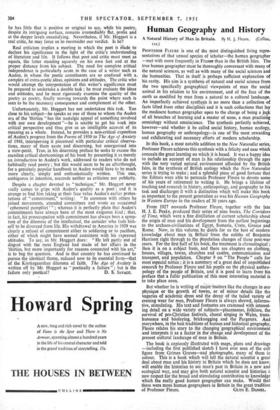Human Geography and History PROFESSOR FLUME is one of the
most distinguished living repre- sentatives of that unsual species of Scholar—the human geographer —met with more frequently in France than in the British Isles. The true human geographer must be thoroughly conversant with many of the natural sciences, as well as with many of the social sciences and the humanities. That in itself is perhaps sufficient explanation of his rarity. His aim is a synthesis of natural and social science from the two specifically geographical viewpoints of man the social animal in his relation to his environment, and of the face of the earth as modified by man from a 4iatural to a cultural landscape. An imperfectly achieved synthesis is no more than a collection of facts lifted from other disciplines and it is such collections that lay the mediocre human geographer open to the charge of being a jack of all branches of learning and a master of none, a man practising omniology without omniscience. The synthesis perfectly achieved, however—and whether it be called social history, human ecology, human geography or anthropologp—is one of 'the most rewarding and exhilarating and necessary efforts of modern scholarship.
In this book, a most notable addition to the New Naturalist series, Professor Fleure achieves this synthesis with a felicity and ease which conceals the great learning on which it is based. It was a happy idea to include an account of man in his relationship through the ages with the very varied natural environment afforded by the British Isles, in the synthesis of British ecology which the New Naturalist series is trying to make ; and a splendid piece of good fortune that the Editors were able to persuade Professor Fleure to devote some of his years of retirement to writing it. He brings a lifetime of teaching and research in history, anthropology, and geography to his task and discharges it with a distinction which will make this book as important to the present generation as was his Human Geogiaphy in Western Europe to the readers of 30 years ago.
From 1927 onwards Professor Fleure, together with the late H. J. E. Peake, produced their series of nine books, The Corridors of Time, which were a fine distillation of current scholarship about the origin of man and his development from the earliest beginnings to the archaeo-civilisations of Egypt, Sumeria, Crete, Greece and Rome. Now, in this volume; he clistils for us the best of modern knowledge about man in Britain from the eoliths of Benjamin Harrison right through to the Ppulation changes of these post-war years. For the first half of his book, the treatment is chronological ; then it is on a subject basis, and there are chapters on clothing, houses, villages, towns, churches and castles, communication and transport, and population. Chapter 9 on " The People " calls for most especial notice ; it is•a summary of a great deal of unpublished research by Professor Fleure and his pupils on the physical anthro- pology of the people of Britain, and it is good to learn from' his preface that a fuller publication of this most interesting material is to take place soon.
But whether he is writing of majdematters like the changes in our physique or the growth of towns, or of minor details like the vagaries of academic dress and the decay of the tailed variety of evening wear for men, Professor Fleure is always shrewd, informa- tive, stimulating. His text and footnotes are crammed with interest- ing detail on a wide variety of subjects—placenames, folklore, the survival of pre-Christian festivals, choral singing in Wales, trans- humance and booleying, bricknogging and the Pargeters. And everywhere, in the best traditions of human and historical geography, Fleure relates his story to the changing geographical environment and interprets it as a factor in.this' change and development of the present cultural landscape of man in Britain.
The book is copiously illustrated with maps, plans and drawings —including the first published sketch I have ever seen of the cult figure from Grimes Graves—and photographs, many of them in colour. This is a book which will tell the natural scientist a great deal about man and his history in'Britain which he does not know, will enable the historian to see man's past in Britain in a new and ecological way, and may give both natural scientist and historian a new respect for the broad and stimulating contribution to knowledge which the really good human geographer can make. Would that there were more human geographers in Britain in the great tradition


































 Previous page
Previous page